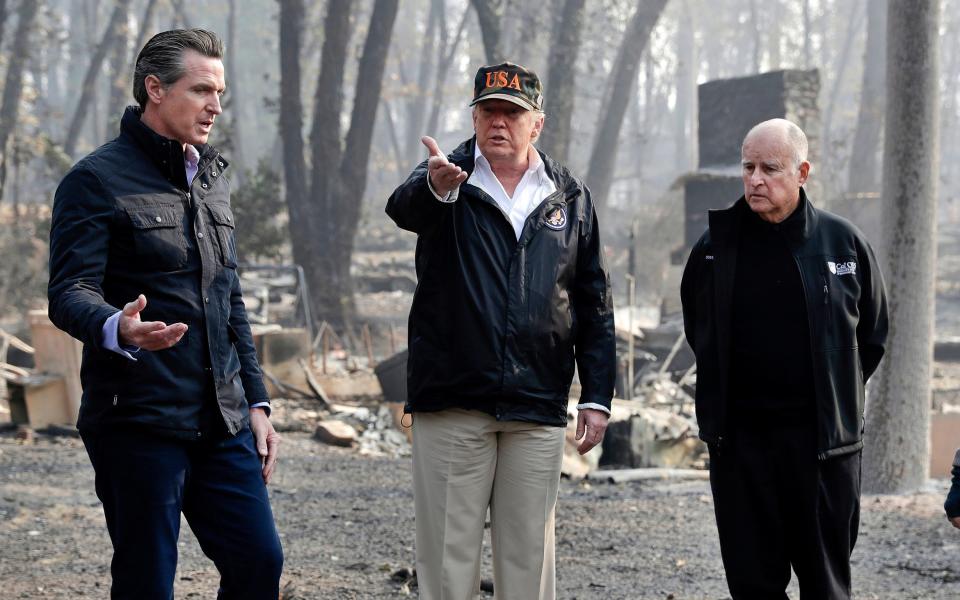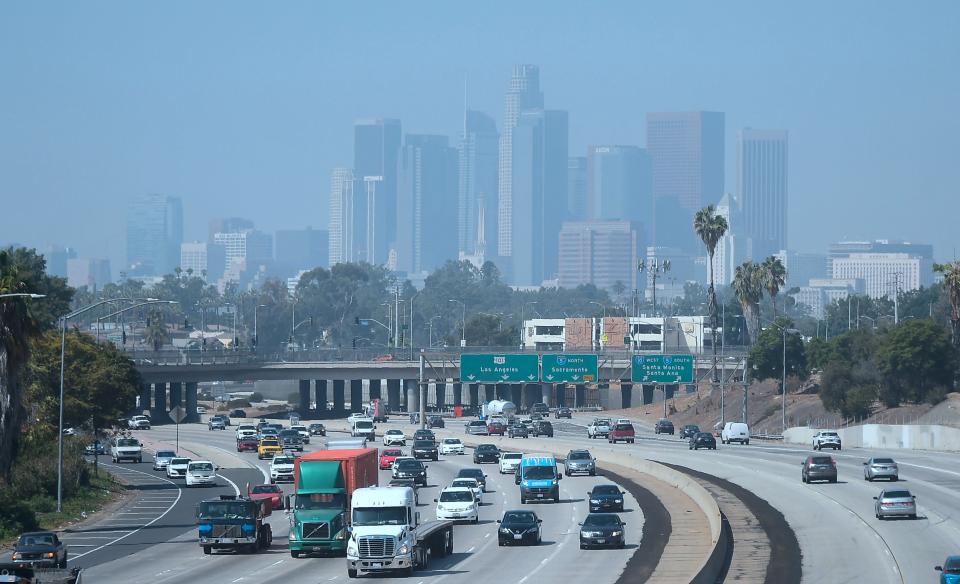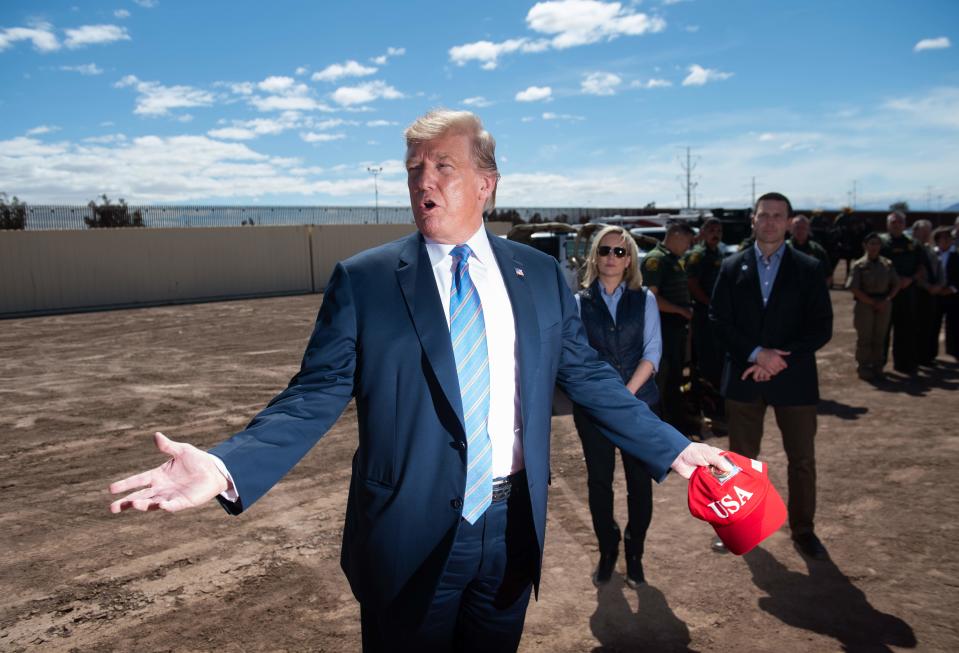Trump's EPA threatens California over air quality; governor says it's 'pure retaliation'

SAN FRANCISCO – First it was homelessness. Then automotive standards. And now it's air quality.
The battle between the Trump administration and California escalated Tuesday as the Environmental Protection Agency threatened to withhold billions in federal highway aid because California has, in the EPA's words, "the worst air quality in the United States."
Reaction from leading Golden State officials was swift and scathing, with particular emphasis on the ironic nature of the threat.
The letter from EPA Administrator Andrew Wheeler to California Air Resources Board chair Mary Nichols arrived just days after President Donald Trump directed his administration to revoke California's waiver on auto emissions, a move that would undercut the state's decades-long effort to improve air quality by setting stringent standards on tailpipe discharges from cars and light trucks.
"This letter is a threat of pure retaliation," Gov. Gavin Newsom said in a statement. "The White House has no interest in helping California comply with the Clean Air Act to improve the health and well-being of Californians."
U.S. Sen. Dianne Feinstein (D-Calif.) called the EPA's warning letter "the height of hypocrisy," adding that "California doesn't need to be lectured by an administration beholden to polluters."
Newsom and Feinstein both noted California's strong environmental track record, particularly in contrast to the Trump administration's withdrawal from the Paris climate agreement and its recent efforts to roll back Obama-era regulations on everything from methane to endangered species.
Newsom and Feinstein also recalled the days when Los Angeles air quality was, as Newsom said, "the color of mud," and playing outside was often curtailed. Only "concerted action" led to improved skies, said Feinstein.
"If the White House wants a fight over what what needs to be done to protect our air, we are happy to have that fight any day," she said.
Industry vs. air quality
The threatened withholding of highway aid comes nearly a year and a half after Trump proposed an industry-friendly rewrite of air quality regulations he says pose "unnecessary and outdated barriers to growth."
The proposed loosening of air quality standards came in the form of a directive Trump issued in April 2018 instructing the EPA to work with states that have metro areas which failed to attain clean air standards. The president's primary aim, the directive states, is "promoting domestic manufacturing and job creation."

Building or expanding major projects, such as highways and manufacturing plants, in these "non-attainment" areas requires extra time and cost to make sure the increased industrial activity won't worsen air quality. And states with non-attainment areas have to file plans with the EPA to show how they're confronting the problem, a review process that can take years.
In his letter, EPA Administrator Wheeler scolded CARB chair Nichols for not doing enough to meet Clean Air Act standards for at least one of six key pollutants — ground-level ozone (smog), particulate matter (soot or smoke), carbon monoxide, lead, sulfur dioxide, and nitrogen dioxide.
As a result, 34 million of the state's 40 million residents live in 82 areas that fail to meet federal ambient air quality standards. Of the roughly 350 State Implementation Plans (SIPs) EPA has on backlog from states that are in non-compliance, about a third – 130 – come from California, the letter said.
"Since the 1970s, California has failed to carry out its most basic tasks under the Clean Air Act," Wheeler wrote.
Wheeler warned California that if it does not withdraw the backlogged SIPs and "work with EPA to develop complete, approvable" plans, the state faces the loss of highway aid and restrictions on the state's ability to approve major projects that could worsen air pollution, such as power plants or industrial facilities. Such projects are regulated under the EPA's New Source Review program.
California Air Resources Board Executive Officer Richard Corey said in a statement that the EPA's letter "contains multiple inaccuracies, omissions and misstatements," adding that the "EPA has unclean hands. It sat on these documents for years and is now pounding the table about paperwork issues of its own creation."
Corey also referred to the recent battle over tailpipe emissions and the federal government's ongoing efforts to get some of the largest automakers to stop collaborating with California on its strict emissions standards.

"This letter appeared only days after EPA attacked our state authority on cars, increasing air pollution while at the same time limiting our ability to reduce it," he wrote. "If the Trump administration is serious about air pollution, it will reconsider revoking our waiver, and while they’re at it, why not also fund the EPA to review submitted documents in less than a decade.”
Trump's California battles
The EPA letter comes less than a week after Trump threatened to use the EPA to warn San Francisco that the city's ongoing struggle with homelessness is violating environmental rules, claiming that needles and other detritus were flowing from the city into the ocean.
Looser restrictions: President Trump directs EPA to ease air quality rules he says suffocates industry
Some environmental experts say the adversarial stance being taken by the Trump Administration runs counter to the traditional role of the federal government on such issues.
The move to punish California "threatens the important partnership among federal, state and local governments in protecting public health," said Bill Becker, an environmental consultant who used to head the National Association of Clean Air Agencies, a trade group representing state regulators.
Becker suggests that Trump's desire to spotlight California smacks of retaliation.
"It is extremely rare for EPA to threaten sanctions against one state when many others, who have not been threatened, are facing the same air quality problems," Becker said in an email. "States should be sanctioned for failing to try, not for trying but failing. In California's case, they are doing everything they can to ameliorate challenging air quality problems."
For Noah Perch-Ahern, who focuses on environmental and energy law at the Greenberg Glusker firm in Los Angeles, the EPA's move "seems political, because it's just unusual that the agency would target a state that is aggressive when it comes to environmental policies especially on air quality."
But he notes that the state isn't likely to feel the effects of any Trump Administration moves for some time. In fact, even if the EPA's ultimate mission were to take over the administration of California's air quality standards, "that's something that couldn't happen until a formal regulatory process was followed," he says. "It would take time."

David Pettit, a Los Angeles-based senior attorney for the National Resources Defense Council, a non-profit environmental advocacy group, says his office location in Santa Monica has the worst ozone problem in the country.
"There is truth to the statement that we have very bad air quality in California," says Pettit. "That just means we have to take heroic steps to fight, but the EPA wants to take away our tools to do that."
Pettit says that his state has been at the forefront of enacting strict environmental policies "from Republican Governor (Arnold) Schwarzenegger on forward." He says any actions resulting from Trump's threat would likely "take at least 18 months and probably run into the next administration in 2021."
Trump, of course, is working to win a second term. If that happens, California likely should brace itself for more attacks that, to many working in the state's environmental circles, seem more personal than professional. To date, the state has filed 60 lawsuits against the Trump administration.
"You could call this a cynical move, but you’d be too kind," says Hal Harvey, CEO of Energy Innovation, a San Francisco-based non-governmental organization focused on reducing greenhouse gas emissions. "It’s a nasty thing to do. It takes gall to do this less than a week after stripping us of ability to reduce pollution" via tailpipe emissions.
Harvey says that managing California's air quality has always been a "devilishly hard job" due to a range of challenges, including unrelenting traffic in its urban cores, a large state population, a vibrant economy and challenging geography.
"But there's no state with better staff to handles these challenges than here in California," he says. "We’ve come a long way. The federal government should be adding to our toolkit, not taking away from it."
Follow USA TODAY national correspondents Marco della Cava and Ledyard King on Twitter: @marcodellacava and @ledgeking
This article originally appeared on USA TODAY: Trump threatens California over air quality; leaders call it hypocrisy

